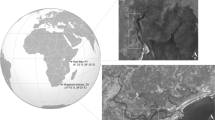Abstract
The Antarctic crustacean Branchinecta gaini (Branchiopoda, Anostraca) occurs in nine fresh water lakes near the Polish H. Arctowski Station. In one of the largest, Lake Wujka (Lake Uncle in English), we determined how temperatures affect its respiration and whether this is sex dependent. Experiments were carried out on males and females bearing eggs over a range of temperatures from 0.5 to 10°C. An ANOVA showed that while the amount of oxygen consumed increased with temperature (P < 0.001) males consumed more oxygen than similarly-sized females bearing eggs (P < 0.001).

Similar content being viewed by others
References
Brendonck L (1996) Diapause, quiescence, hatching requirements: what we can learn from large freshwater branchiopods (Crustacea: Branchiopoda: Anostraca, Notostraca, Conchostraca). Hydrobiologia 320:85–97
Brendonck L, Riddoch BJ (2000) Egg bank dynamics in anostracan desert rock pool populations (Crustacea: Branchiopoda). Arch Hydrobiol 148:71–84
Graham TB (2002) Survey of aquatic macroinvertebrates and amphibians at Wupatki National Monument, Arizona, USA: an evaluation of selected factors affecting species richness in ephemeral pools. Hydrobiologia 486:215–224
Hamer ML, Brendonck L (1997) Distribution, diversity and conservation of anostraca (Crustacea: Branchiopoda) in Southern Africa. Hydrobiologia 359:1–12
Janiec K (1993) The freshwater micro- and meiofauna of Admiralty Bay, King George Island, South Shetland Islands. Proc NIPR Symp Polar Biol 6:133–138
Jurasz W, Kittel W, Presler P (1983) Life cycle of Branchinecta gaini Daday, 1910, (Branchiopoda, Anostraca) from King George Island, South Shetland Islands. Polish Polar Res 4:143–154
King JC (1994) Recent climate variability in the vicinity of the Antarctic Peninsula. Int J Climatol 14:357–369
King JC, Harangozo SA (1998) Climate change in the western Antarctic Peninsula since 1945: observations and possible causes. Ann Glaciol 27:571–575
Knight AW, Lippson RL, Simmons MA (1975) The effect of temperature on the oxygen consumption of two species of fairy shrimp. Am Midl Nat 94:236–240
Murphy JM, Mitchell JFB (1995) Transient response of the Hadley Centre coupled ocean-atmosphere model to increasing carbon dioxide. Part II: spatial and temporal structure of response. J Climatol 8:496–514
Paggi JC (1996) Feeding ecology of Branchinecta gaini (Crustacea: Anostraca) in ponds of South Islands, Antarctica. Polar Biol 16:13–18
Peck LS (1998) Feeding, metabolism and metabolic scope in Antarctic marine ecotherms. In: Pörtner HO, Playle RC (eds) Cold ocean physiology. Society for Experimental Biology Seminar Series no 66. Cambridge University Press, Cambridge, pp 365–390
Peck L (2002a) Ecophysiology of Antarctic marine ectotherms: limits to life. Keynote contribution, Antarctic Treaty Organisation Scientific Committee on Antarctic Research, Ecology of the Antarctic Sea Ice Zone, Bremerhaven, June 1999. Polar Biol 25:31–40
Peck L (2002b) Coping with change: stenothermy, physiological flexibility and environmental change in Antarctic seas. In: Proceedings of the 14th international congress on comparative physiology. La Troina, Sicily. http://www.liv.ac.uk/ciliate/climate/peck.html
Peck L (2004) Physiological flexibility: the key to success and survival for Antarctic fairy shrimps in highly fluctuating extreme environments. Freshw Biol 49:1195–1205
Peck L (2005) Prospects for surviving climate change in Antarctic aquatic species. Front Zool 2:9. http://www.frontiersinzoology.com/content/2/1/9
Peck L, Conway LZ (2000) The myth of metabolic cold adaptation: oxygen consumption in stenothermal Antarctic bivalves. In: Harper EM, Taylor JD, Crame JA (eds) The evolutionary biology of the Bivalvia. Geological Society (Special Publications, 177), London, pp 441–445
Quayale WC, Peck LS, Ellis-Evans CJ, Peat HJ, Harrigan PR (2002) Extreme responses to climate change in Antarctic lakes. Science 295:645
Quayale WC, Convey P, Peck LS, Ellis-Evans CJ, Butler HG, Peat HG (2003) Ecological responses of maritime Antarctic lakes to regional climate change. Antarct Res Ser 76:335–347
Rakusa-Suszczewski S (1992) Zatoka Admiralicji. Antarktyka, Oficyna Wydawnicza, Instytut Ekologii PAN, Dziekanów Leśny
Ripley BJ, Holtz J, Simovich MA (2004) Cyst bank life-history model for a fairy shrimp from ephemeral ponds. Freshw Biol 49:221–231
Acknowledgments
I am deeply grateful to Dr. L. A. Błędzki for critical opinion concerning the text and Dr. P. Olejniczak for statistical analysis. I want to thank Professor S. Rakusa-Suszczewski for enabling me to the participation in XXVIII the Polish Antarctic Expedition to H. Arctowski Station. This study was supported by the State Committee for Scientific Research, Warsaw, grant No. PBZ -KBN-108/PO4/2004.
Author information
Authors and Affiliations
Corresponding author
Rights and permissions
About this article
Cite this article
Pociecha, A. Effect of temperature on the respiration of an Antarctic freshwater anostracan, Branchinecta gaini Daday 1910, in field experiments. Polar Biol 30, 731–734 (2007). https://doi.org/10.1007/s00300-006-0230-6
Received:
Revised:
Accepted:
Published:
Issue Date:
DOI: https://doi.org/10.1007/s00300-006-0230-6




